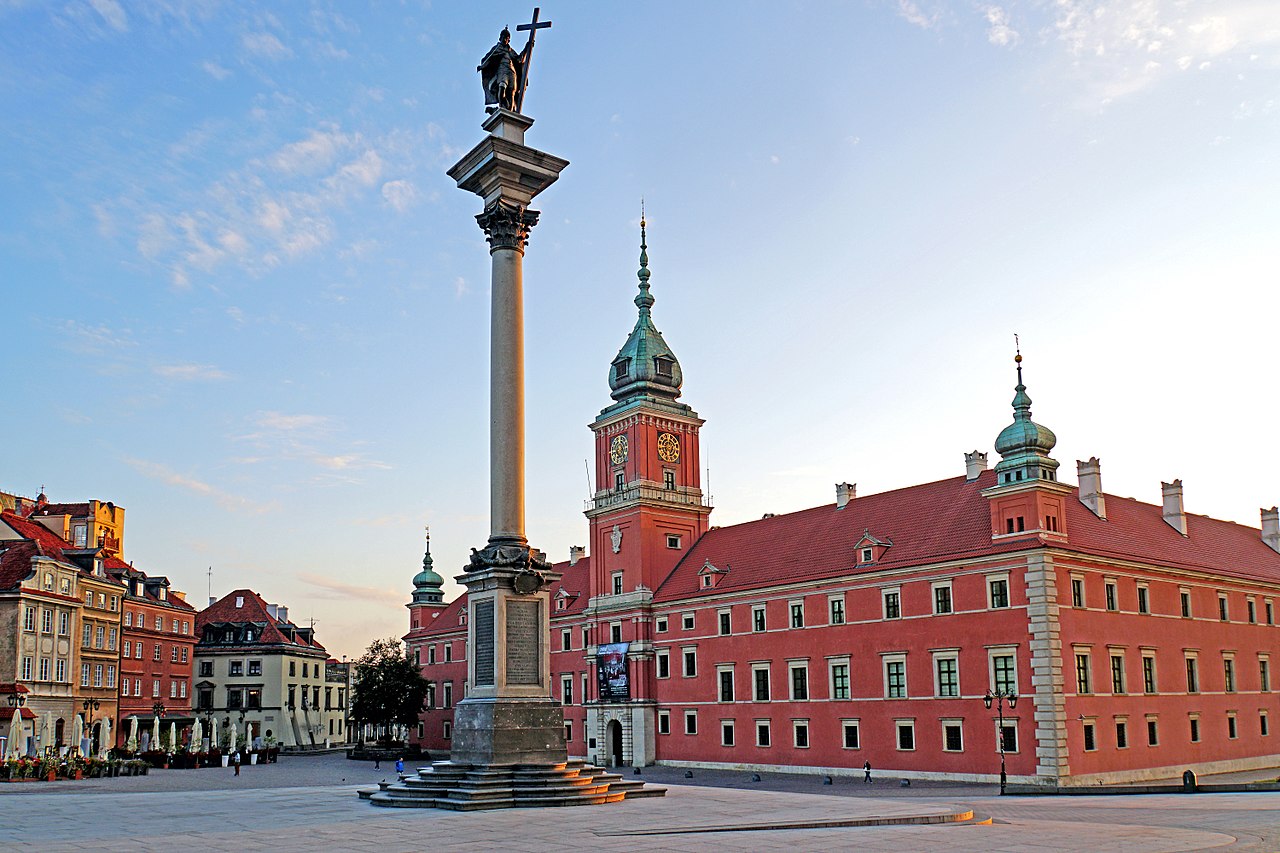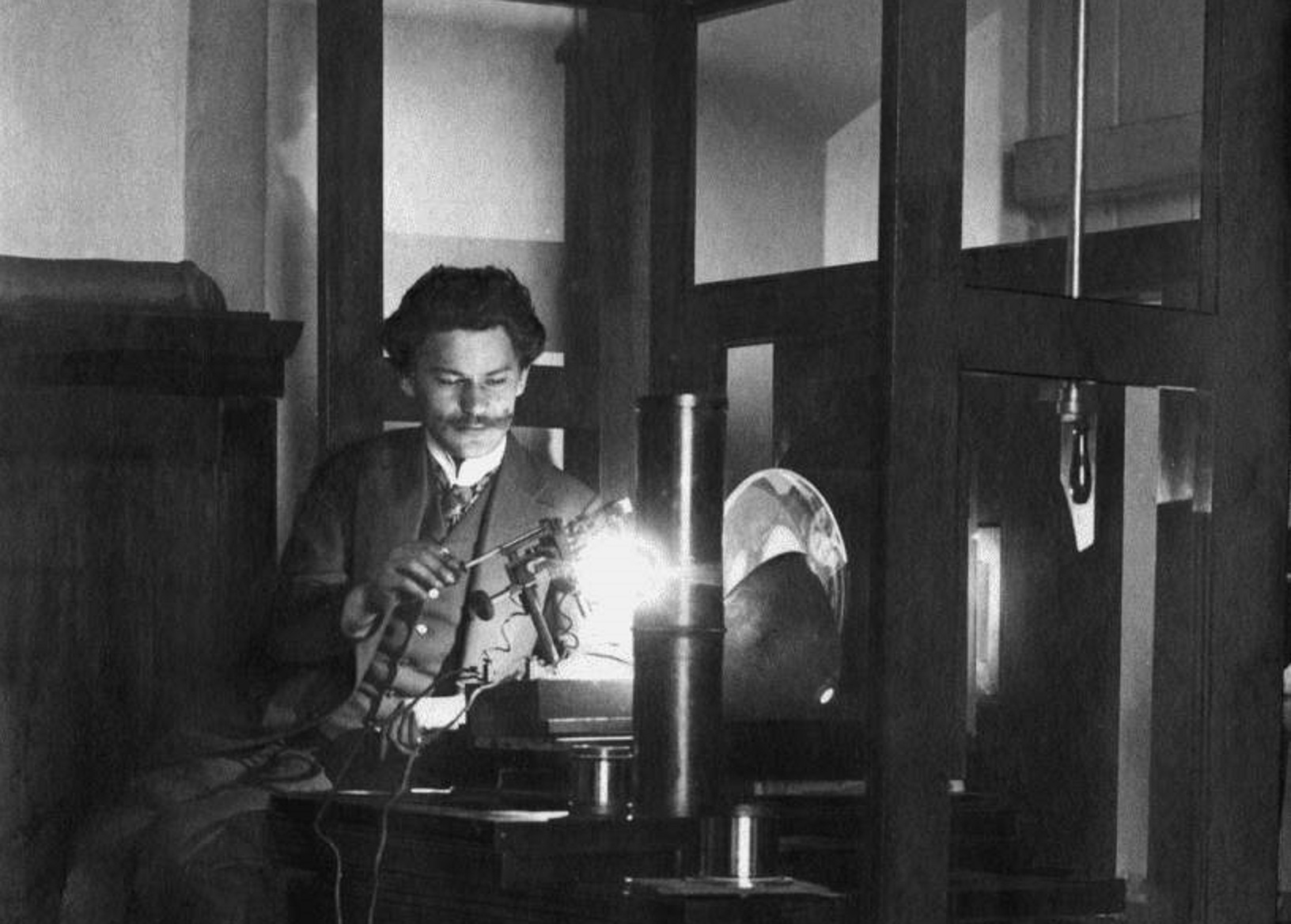The former seat of Masovian dukes and Polish-Lithuanian monarchs has remained a symbol of Polish statehood for centuries. It was the venue of parliamentary sessions and witnessed triumphs (such as the homage paid to King Sigismund III by the Russian Tsar taken prisoner), but also shameful events, such as the consent of corrupt and intimidated MPs to the country’s First Partition. After Poland regained sovereignty, the writer Stefan Żeromski (known as the ‘conscience of the nation’) lived in the Castle before the President of Poland moved in there.
by Wiesław Chełminiak
Stepwise execution
After Poland had been partitioned, Warsaw fell into the hands of the Prussians, and then – for a century – of the Russians. The royal residence retained its prestigious character as the seat of tsarist governors and governors-general, but was gradually stripped of its original furnishings. Even Napoleon, when he visited the area, took the works of art he liked best as ‘souvenirs’. However, the German occupiers proved to be the worst. Immediately after the capitulation of Warsaw, in the autumn of 1939, they began not only to loot the Castle, but also to devastate it. The robbery was supervised by the prominent art historian Dagobert Frey, who had visited Poland before. ‘According to his pre-war notes, he indicated which sculptures should be taken away, which marble fireplaces should be broken, which wood panelling should be torn off,’ recalled an eyewitness to the acts of vandalism, the director of the capital’s National Museum Stanisław Lorentz.
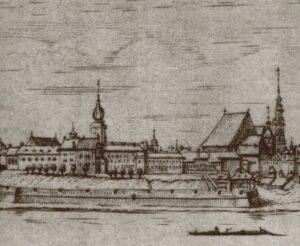
Governor-General Hans Frank tore the silver eagle from the canopy over the royal throne with his own hands. His subordinates followed his example. Appointed supervisor of the Third Reich-occupied part of Poland, Frank moved to Kraków’s Wawel Castle, which he decided to ‘beautify’ with paintings and sculptures stolen from the Royal Castle. The Warsaw residence of the kings was already in a deplorable state at that time. From the beginning of the siege, it became one of the favourite targets of German artillery. The shelling culminated on 17 September, on Hitler’s personal order, who watched the battle for the Polish capital from the tower of a church in Marysin Wawerski. The sight of the burning Sigismund Tower, recorded on film and in photographs, became a symbol of national tragedy. On the same day, Poland was attacked from the east by the Third Reich’s ally, the Soviet Union. That sealed the outcome of the country’s defensive war.
No-one was under any illusion what fate the Germans were preparing for the battered building, especially since they had forbidden to repair the roofs and removed the heaters from the interior. Wehrmacht sappers began drilling holes in the walls for explosive charges. Few people knew that 80 per cent of the historical items had been saved thanks to the dedication of the firemen and Castle staff. Before he died, hit by a shrapnel, Custodian Kazimierz Brokl carried out a patriotically-charged relic from the chapel – an urn with the heart of Tadeusz Kościuszko, the leader of the first anti-Russian uprising and a hero of the American War of Independence.
It was taken to the National Museum for safekeeping. Professor Lorentz and his colleagues, citing an alleged order from the Governor General, attempted to retrieve from the doomed building as many fragments of the interior decoration and architectural details as possible, in order to facilitate (and make easier) its post-war reconstruction.
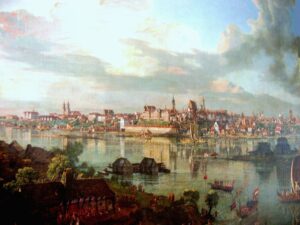
The gutted body of the Castle continued to haunt until the autumn of 1944. After the fall of the Warsaw Rising, the Germans began to systematically demolish the city. After 600 years of uninterrupted existence, the seat of the rulers of one of the largest countries in Europe was left as a pile of rubble.
Gomułka’s eaten hat
When the cannons fell silent, the ruined capital of Poland revived in a flash. The rebuilding of the most important monuments seemed to be a matter of course, which even the new usurper government from Moscow had to acknowledge. The Grodzka Gate portal was hastily assembled from the surviving fragments, which the public perceived as a harbinger of the imminent resurrection of the royal residence. The Sejm, elected in rigged elections, decided that the Castle would be rebuilt within five years ‘as the seat of the highest authorities of the People’s Republic of Poland and a centre for the cultural life of the popular masses’.
Architecture was the favourite of the communist party leader Bolesław Bierut. Considering himself to be the future occupant of the Castle, he instructed the architects that ‘the hasty approach of conservators raises sharp objections’, and that ‘one should not be embarrassed by historical interiors’. The residence was to be reborn not in its historical shape, but in the form of a socialist realism-styled shell. There were voices calling for the addition of a large dome, several storeys high, and raising the building so that it covered the cathedral towering over the Old Town. That resembled the Germans’ plans to erect a gigantic People’s Hall on the Vistula embankment. Edmund Goldzamt, an architect educated in Moscow, went the furthest – he designed a modern skyscraper, which he wanted to place where the Castle had been.

Meanwhile, Krakowskie Przedmieście Street, the starting point of the Royal Route and the oldest medieval district of the city, was being rebuilt nearby. However, the communists took the opportunity to give it a more secular character. The historic house fronts were restored, but the spell was broken when one went inside or into the courtyard. It turned out that underneath the historical costume there was a modern housing estate. To this day, a plaque on a corner tenement announces that the square is a ‘commemoration of the revolutionary struggles of the people of Warsaw’. This could not be said of the Castle, which was one of the reasons why its reconstruction was postponed indefinitely.
After the deaths of Stalin and Bierut, the authorities, until recently dazzled by visions of great investment, became less ambitious. The plan to build an underground in the capital was postponed by many years. In spite of that, Professor Lorentz tried to interest the new government team in the fate of the Castle. He kept fragments of columns, floors, furniture, window frames, doors, candlesticks, fireplaces, paintings and mouldings in the National Museum, which he managed. A group of enthusiasts, not waiting for a political decision, prepared plans for the reconstruction of the Castle interiors.
The new party leader, Władysław Gomułka, was thought to be a patriot yet in reality he was an orthodox communist. He had an unequivocally negative attitude to ‘mementoes of feudalism’. In vain did Lorentz suggest that the 20th anniversary of the Polish People’s Republic or the 1000th anniversary of the founding of the Polish state should be celebrated by rebuilding the seat of the kings. Gomułka told him straight out that he would sooner eat his hat than allow it. State censors made sure that the media did not mention the matter. The Castle cellars, which had been uncovered during the initial works, were filled in, the area was levelled and paved with stone slabs. Lawns and concrete flowerbeds appeared. Several benches were placed for those waiting for city buses. The view of the Vistula was somewhat spoilt by a fragment of the corner of the Saxon wing of the building, considered a permanent ruin. At the foot of the escarpment, stone elements of the destroyed Castle were overgrown with weeds.
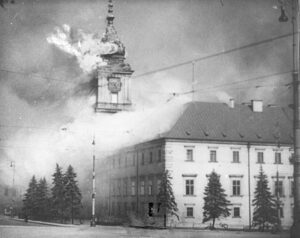
Pass the brick
Gomułka came to power in the autumn of 1956. He lost it 14 years later, after a bloodbath inflicted on workers from the coast. His successor, Edward Gierek, was made of a different clay. He felt obliged to make a nice gesture towards society. He also sought recognition in the eyes of the cultural elite. On 19 January 1971, the ruling party’s top leadership took a decision, which Gierek personally communicated the following day to ‘representatives of creative circles’: the Castle was to be reconstructed.
Lorentz, a descendant of a German hatter who came to Warsaw at the end of the 18th century, triumphed. His persistence was rewarded – he became vice-chairman of the Citizens’ Committee for the Rebuilding of the Royal Castle. The chair was reserved for the head of the Warsaw party structures. The investment was financed by voluntary contributions, which was unique in the entire communist bloc. In the USSR and its satellite states, ‘community action’ was always associated with compulsion.
The reconstruction cost much less than expected – 500 million zlotys. The Committee received income from football matches and horse races, concerts and raffles, and donations from the faithful collected during Sunday church services. The great glass money box at Castle Square was never empty. In the spring, the first volunteers appeared on the building site, with a total of over 27,000 people working without pay. This generosity confirmed the fact that for Poles the Castle was a symbol of lost independence. Propaganda films showed policemen and miners throwing bricks in the air wearing formal clothes. The army and state industrial plants helped (there were no others in the country).

The Committee’s appeal to Poles living abroad divided the émigré circles. The writer Józef Mackiewicz argued that the Castle would serve ‘the comfort and prestige of the Polish Bolsheviks’, and called on patriots to boycott the collection. The head of the influential Paris-based Kultura Jerzy Giedroyc called the request for support a ‘diversion’. However, Jan Nowak-Jeziorański, the director of the Polish section of Radio Free Europe, thought it necessary to demonstrate solidarity with his compatriots back home. The Committee had little effect in anti-communist London. Things went better in America, because the Polish diaspora there was more affluent and sentimental.
Kraków versus Warsaw
Three years after the first shovel had been thrust into the ground, the building was already finished in its raw state. The clock on the Sigismund Tower that stopped ticking on the tragic day of 17 September 1939 was re-activated. The facade of the Castle from the side of the city regained its early baroque shape from the times of the Vasa dynasty, from the side of the Vistula river the style of Saxon Rococo reigned supreme. The biggest challenge was to recreate the interiors on the basis of pre-war photographs, drawings and descriptions from the late 18th century. Wherever possible, original elements of the decor were inserted.
The reconstruction of the canopy in the Throne Room was helped by finding one of the original silver eagles in Canada. The panelling, wall ornaments and picture frames were covered with a thin layer of highest-quality gold. A total of 40 kilograms of it was used. The metal of a slightly lower quality was used to decorate clock faces, knobs on towers, handles and candelabra. Meanwhile, in the secrecy of the cabinets, the dispute between the party’s top leadership and museum workers escalated. Gierek dreamt of returning to the pre-war status quo when the head of state used to reside in the former seat of kings. However, the country began to experience an economic crisis, which in 1980 unsaddled him. Lorentz won again – one of his deputies from the National Museum, Professor Aleksander Gieysztor, was appointed director of the Castle.
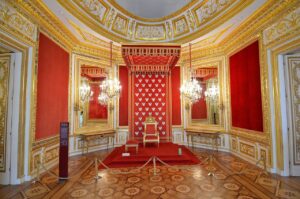
The building was opened to the public on 31 August 1984. Experts questioned the colour of the plasterwork and the shape of the corner turrets. The former shape of the Chamber of Deputies, divided into two smaller halls in Russian times out of revenge for the dethronement of the Tsar voted here in January 1831, was not restored. Communists were unfamiliar with the traditions of parliamentarism, and according to a popular opinion the Polish-Lithuanian Sejm was not up to the task. Visitors left the Castle delighted, even though only a tenth of what can be seen today was there.
The museum collection was supplemented by purchases and donations. The Prime Minister of Sweden, Olof Palme, donated a priceless gouache, stolen by his countrymen in the 17th century, depicting the ceremonial entry into Kraków of the wedding procession of King Sigismund III Vasa. The Castle also received a part of the Lanckoroński collection, including two paintings by Rembrandt and a priceless collection of old maps of the businessman Tomasz Niewodniczański.
Today, the former royal residence leads a double life. It hosts exhibitions of Polish and foreign works of art, old music festivals, cultural events and historical lectures. Politics has also returned to the reconstructed building. In its Society Room, John Paul II and the last leader of communist Poland General Wojciech Jaruzelski held talks in June 1987 at a round Rococo table, salvaged from its former furnishings. A visit to the Castle is a must on the agenda of visits paid by presidents, prime ministers and monarchs to Poland. They are surprised to find that over 80 per cent of the furnishings are authentic.

The traditional animosity between the old and new Polish capitals has meant that in Kraków one can hear more often than elsewhere that the ‘Warsaw Castle is a dummy’. Varsovians retort that Wawel Castle is a shell. After all, nothing from its furnishings has survived, except for the tapestries of King Sigismund II Augustus and the throne of Stephen Báthory. Incidentally, both buildings are on the UNESCO World Heritage List. Their reconstruction became a model for neighbouring countries (the Jagiellonian Residence in Vilnius, the Habsburg Castle in Bratislava, the Wettin Castle in Dresden, or the Hohenzollern Palace in Berlin).
The final touch to the reconstruction of the Warsaw Castle was the restoration of its gardens. Made available to the public in the spring of 2019, they are to reach as far as the Vistula River in the future. The hope that more of the Castle’s monuments swallowed up by the dark night of the country’s partitions and occupation will be found is also not diminishing.
Author: Wiesław Chełminiak
Translation: Mikołaj Sekrecki

